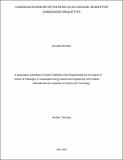| dc.description.abstract | Charcoal is the predominant fuel used in many developing countries for domestic and commercial
purposes. Transport and handling of charcoal produces fines amounting to 10-20% by weight. The
fines can be turned into lumps of charcoal by briquetting using suitable binders. This study
investigated the use of Canarium Schweinfurthii resin as a binder for production of carbonized
briquettes from charcoal fines. The binder and charcoal fines were characterized through
proximate analysis, ultimate analysis, higher heating value (HHV), and SEM. Four briquette
samples (B25, B30, B35, and B40) with a ratio of charcoal fines: binder of 3:1, 7:3, 13:7, and 3:2,
respectively were produced at a compaction pressure of 5.92-7.96 MPa. The physical properties
of briquettes determined were bulk density, impact resistance index (IRI), compressive strength
(CS), splitting tensile strength (STS), water resistance index (WRI), and morphology. The
chemical properties of briquettes determined were proximate analysis, ultimate analysis, HHV,
and energy density. The physical properties of briquettes were analysed using Design Expert. One way ANOVA and Fisher’s LSD were used to analyse the chemical properties of briquettes. The
phases of the Water Boiling Test (WBT) considered were Cold Start High Power, Hot Start High
Power and Simmer phases. Ignition properties, combustion properties, gas temperature, water
temperature, ambient temperature, emissions, and WBT performance metrics were investigated
using the Laboratory Emission Monitoring System. The ignition properties included ignition time,
flame and incandescence. The combustion properties included smoke, flame, soot, and ash. The
emissions measured were PM2.5, S𝑂2, 𝑁𝑂𝑥, 𝐶𝑥𝐻𝑦, 𝐶𝑂, and 𝐶𝑂2. The WBT performance metrics
evaluated were time to boil, burning rate, thermal efficiency, specific fuel consumption, firepower,
total emissions, specific emissions, emissions per MJ, and emissions rate. The ash from charcoal
fines was analysed using x-ray diffraction. The briquettes had a bulk density of 0.770-1.036 g/cm3
,
IRI of 2.90-73.33, CS of 2.25-10.94 MPa, STS of 0.09-0.42 MPa, WRI of 99.26-99.29, and an
HHV of 29.7-31.3 MJ/kg. The ignition time was 6.47-7.01 min, time to boil was 14.7-41.9 min,
burning rate was 1.1-8.2 g/min, thermal efficiency was 21.79-54.61%, specific fuel consumption
was 21.7-70.1 g/L, and firepower of 535.9-4123.2 W. The ash was found to contain 𝐶𝑎𝐶𝑂3
(76.6
wt%), 𝐶𝑎𝑂 (13.1 wt%) and amorphous compounds (10.3 wt%). Design Expert predicted briquette
B40 with the optimum physical properties. The produced briquettes can be used as an alternative
source of fuel to wood fuel since they exhibit similar combustion properties. | en_US |

